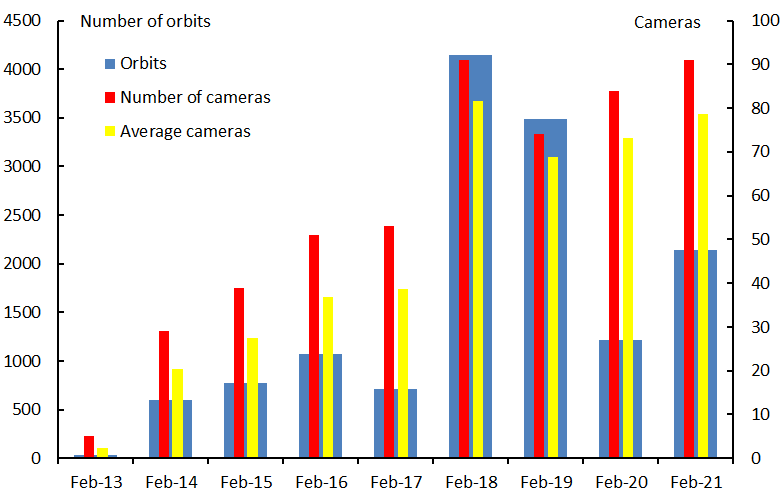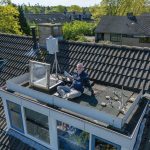Abstract: A summary of the results of the CAMS BeNeLux network during the month February 2021 is presented. This month displayed a normal weather pattern for this time of the year without being exceptional bad or poor. In total 6922 multiple station meteors were recorded, good for in total 2131 orbits. The number of available cameras increased from 84 in 2020 to 91 in 2021.
1 Introduction
The months of February in 2018 and in 2019 were exceptional favorable months for CAMS but last year weather remained extremely poor during this month. After an exceptional poor January 2021, we all looked forward to see some improvement during February 2021.
2 February 2021 statistics
The month started with the same poor weather pattern as we had in January. An improvement occurred on 10 February with a series of mostly clear nights followed by variable weather with partial clear nights. Eight nights had over 100 orbits (3 nights in 2020). February 2019 had eight nights with more than 200 orbits, 2018 even had eleven nights with over 200 orbits, 2021 had just 3 nights with more than 200 orbits.
CAMS BeNeLux managed to collect 6922 multi-station meteors (against 3517 in 2020 and 10570 in 2019) with a maximum of 91 cameras capturing at 26 participating stations. Only 3 nights remained without any single orbit obtained (compared to 5 nights without orbits in 2020). This was good for 2131 orbits (against 1215 in 2020 and 3485 in 2019). With the 2021 results the total number of orbits for February obtained by CAMS BeNeLux is 14191 orbits collected in 190 successful February nights. The statistics for February 2021 are compared in Table 1 with all previous February months since the start of the CAMS BeNeLux network. Some better weather than last year combined with more operational cameras at more participating stations resulted in a higher number of orbits.
On average 78.6 of the available 91 cameras were capturing each night (73.1 of 84 in 2020). In the first years, before AutoCAMS was available in the BeNeLux, many cameras remained switched off when the weather did not look good in the evening. This way the chances to obtain double station meteors for the cameras that remained active were rather small. Luckily, many camera stations function 7 on 7 now. AutoCAMS kept a minimum of 60 cameras active on all nights, even on completely overcast nights (compared to 62 in 2020). On as many as 24 nights orbits have been collected just like during previous year. Figure 1 shows the camera capacity got restored compared to 2018 and the network got back at its strength of February 2018.

Figure 1 – Comparing February 2021 to previous months of February in the CAMS BeNeLux history. The blue bars represent the number of orbits, the red bars the maximum number of cameras running in a single night and the yellow bars the average number of cameras running per night.
Table 1 – February 2021 compared to previous months of February.
| Year | Nights | Orbits | Stations | Max. Cams | Min. Cams | Mean Cams |
| 2013 | 9 | 38 | 6 | 5 | 2.3 | |
| 2014 | 21 | 601 | 12 | 29 | 20.3 | |
| 2015 | 21 | 777 | 14 | 39 | 27.4 | |
| 2016 | 24 | 1075 | 17 | 51 | 13 | 36.9 |
| 2017 | 16 | 717 | 18 | 53 | 20 | 38.6 |
| 2018 | 26 | 4147 | 22 | 91 | 48 | 81.7 |
| 2019 | 24 | 3485 | 18 | 74 | 50 | 68.8 |
| 2020 | 24 | 1215 | 22 | 84 | 62 | 73.1 |
| 2021 | 25 | 2136 | 26 | 91 | 60 | 78.6 |
| Total | 190 | 14191 |
3 Conclusion
February 2021 was an average month with typical weather for this time of the year with no exceptional good or bad weather circumstances. The total number of orbits puts this month as the 3rd best month of February for the CAMS BeNeLux network.
Acknowledgment
Many thanks to all participants in the CAMS BeNeLux network for their dedicated efforts. The data on which this report is based has been taken from the CAMS website. The data from all stations were collected and the trajectories and orbits calculated by Carl Johannink. The CAMS BeNeLux team is operated by the following volunteers:
Hans Betlem (Leiden, Netherlands, CAMS 3071, 3702 and 3073), Felix Bettonvil (Utrecht, Netherlands, CAMS 376 and 377), Jean-Marie Biets (Wilderen, Belgium, CAMS 379, 380, 381 and 382), Martin Breukers (Hengelo, Netherlands, CAMS 320, 321, 322, 323, 324, 325, 326 and 327), Guiseppe Canonaco (Genk, RMS 3815), Pierre de Ponthiere (Lesve, Belgium, RMS 3816), Bart Dessoy (Zoersel, Belgium, CAMS 397, 398, 804, 805, 806), Tammo Jan Dijkema (Dwingeloo, Netherlands, RMS 3198, 3199), Jean-Paul Dumoulin, Dominique Guiot and Christian Walin (Grapfontaine, Belgium, CAMS 814 and 815, RMS 3814), Uwe Glässner (Langenfeld, Germany, RMS 3800), Luc Gobin (Mechelen, Belgium, CAMS 3890, 3891, 3892 and 3893), Tioga Gulon (Nancy, France, CAMS 3900 and 3901), Robert Haas (Alphen aan de Rijn, Netherlands, CAMS 3160, 3161, 3162, 3163, 3164, 3165, 3166 and 3167), Robert Haas (Texel, Netherlands, CAMS 810, 811, 812 and 813), Robert Haas / Edwin van Dijk (Burlage, Germany, CAMS 801, 802, 821 and 822), Kees Habraken (Kattendijke, Netherlands, RMS 378), Klaas Jobse (Oostkapelle, Netherlands, CAMS 3030, 3031, 3032, 3033, 3034, 3035, 3036 and 3037), Carl Johannink (Gronau, Germany, CAMS 311, 314, 317, 318, 3000, 3001, 3002, 3003, 3004 and 3005), Hervé Lamy (Dourbes, Belgium, CAMS 394 and 395), Hervé Lamy (Humain Belgium, CAMS 816), Hervé Lamy (Ukkel, Belgium, CAMS 393), Koen Miskotte (Ermelo, Netherlands, CAMS 351, 352, 353 and 354), Tim Polfliet (Gent, Belgium, CAMS 396), Steve Rau (Zillebeke, Belgium, CAMS 3850 and 3852), Paul and Adriana Roggemans (Mechelen, Belgium, CAMS 3832, 3833, 3834, 3835, 3836 and 3837, RMS 3830 and 3831), Hans Schremmer (Niederkruechten, Germany, CAMS 803) and Erwin van Ballegoij (Heesch, Netherlands, CAMS 347 and 348).





